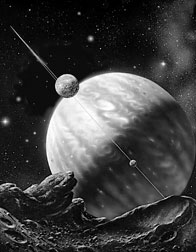New worlds, new vistas
 This column usually focuses on terrestrial matters, but it is time to
go extra-terrestrial for just one week. The space buff in me is simply
at a loss for words to describe the feeling of euphoria after hearing
the news that there are thousands of Earth-sized planets in our galaxy
alone. Count the other galaxies in, and you probably have millions more
Earth-like exoplanets (planets outside our solar system) to choose from
in the whole universe. This column usually focuses on terrestrial matters, but it is time to
go extra-terrestrial for just one week. The space buff in me is simply
at a loss for words to describe the feeling of euphoria after hearing
the news that there are thousands of Earth-sized planets in our galaxy
alone. Count the other galaxies in, and you probably have millions more
Earth-like exoplanets (planets outside our solar system) to choose from
in the whole universe.
This discovery has been made by NASA's Kepler Space Mission, the
space observatory purpose built to discover Earth-like planets orbiting
distant stars. Why is this discovery so exciting ?
Until now, information on the most exciting class of potential
planet, more similar to the earth and less like the gas giants such as
Jupiter, was sparse. We do not know, in the strictest sense of the word,
whether many or all of them are Earth-like. Earth-sized is the more
accurate description, but there are plenty of reasons to be happy about.
The first is that there are far more exoplanets out there than the
number we already know. Most of the exoplanets that we already know
about are giants, possibly Jupiter-like. Astronomers knew that smaller
exoplanets exist, but this is the first time that they have been
detected in large numbers. Of course, there should be more smaller
planets than larger ones in the galaxy, judging just by the composition
of our own solar system.
 The most significant reason is that the discovery of the planets may
help answer the question 'are we alone in the Universe ?'. It will take
many more years of research and more space missions to answer this
question, but the chances of answering it in the affirmative just
received a boost. (There really are no 'pictures' of these planets.
Kepler is a highly accurate photometer married to a powerful wide view
telescope designed to detect minute changes in stellar brightness as
planets cross in front of a parent star. And Kepler can look at around
100,000 stars at once). The most significant reason is that the discovery of the planets may
help answer the question 'are we alone in the Universe ?'. It will take
many more years of research and more space missions to answer this
question, but the chances of answering it in the affirmative just
received a boost. (There really are no 'pictures' of these planets.
Kepler is a highly accurate photometer married to a powerful wide view
telescope designed to detect minute changes in stellar brightness as
planets cross in front of a parent star. And Kepler can look at around
100,000 stars at once).
If there are many more Earth-sized planets in the universe, at least
some of them could be candidates for harbouring life, even intelligent
life. That will fundamentally alter the way we look at ourselves.
Our planet, the Earth, is perfectly placed to host life. It is at
just the right distance from a star (Sun), it has an atmosphere and
water and it is not too large. There could be other planets in other
'solar' systems which have similar conditions. That could be a harbinger
for life, at least of the microbial variety. Or they may be having the
primordial conditions which led to the evolution of life here on Earth.
While these planets may share similar traits with the Earth, they
could also be different and spectacularly so. They will be different in
terms of terrain and life forms, if any. Astronomers use several terms -
super-earths, water worlds, methane planets, gas dwarfs, and even carbon
(think substances like diamond !) planets.
Super-earth refers to terrestrial planets -- icy, rocky, liquid, or
gas dwarfs -- that are larger than Earth. A water world is exactly that
- a planet made up mostly of water, a la Kevin Costner's Waterworld. On
such a world the ocean would be hundreds to thousands of kilometres
deep. Or it could be ice. In methane worlds, water is replaced by
natural gas.
Carbon planets would be made up of carbon compounds and given the
presence of water, would be candidates for life. That is the basis of
life as we know it. But what about life 'as we do not know it' ? There
could well be other compounds which may have given life to bizarre forms
of life in these exoplanets.
Exoplanets apart, our own solar system may have a spark of life in
bodies other than the Earth. There is a lot of speculation about Mars,
but scientists are even more excited about the likes of Titan, the
largest moon of Saturn. Some scientists believe that unusual creatures,
capable of withstanding extreme temperatures can be found on Titan,
which has a very dense atmosphere. Winds blow on Titan, which has
methane rain, volcanoes and experiences earthquakes. The only difference
is the temperature of minus 180 degree Celsius. The present Cassini
probe and another probe scheduled to go there by 2017 will perhaps
provide the answers. Titan could be a model for the exoplanets we may
find.
While Titan is accessible for a robotic landing probe or even a
manned probe, most of the exoplanets are hundreds of light years away.
(A light year is the distance light travels in a year - around 10
trillion kilometers). Unless a now-unthinkable propulsion system
(remember Star Trek ?) is invented in the far future, deep space travel
will remain a dream. It might never be possible to actually physically
search for life in exoplanets. The good news is that technology will
most probably be available to get more detailed images of exoplanets
over the next 20 years.
The next best thing is to wait for a signal from deep space,
signifying intelligent life. Astronomers have been doing that for
decades, with no success. We have also sent a physical message on
spacecraft that are now in deep space and we are also broadcasting
non-stop to space. Someone out there might respond or even visit us.
But are not aliens visiting us already ? There are many unexplained
sightings of Unidentified Flying Objects, but no one has conclusively
proven that alien spacecraft have landed on Earth. Such an encounter
will, of course, change everything.
In the meantime, the implications of the Kepler discovery are nothing
short of exciting: there are billions of stars in the Milky Way galaxy,
many millions of them are as old as our sun. If Kepler's data are true,
there are probably millions of earth-like planets that have been
circling stars long enough for life to evolve, if the history of Earth
itself is any indication. We may not be alone in the universe, after
all. As Sir Arthur C Clarke said, "Sometimes I think we're alone in the
universe, and sometimes I think we're not. In either case the idea is
quite staggering".
|

